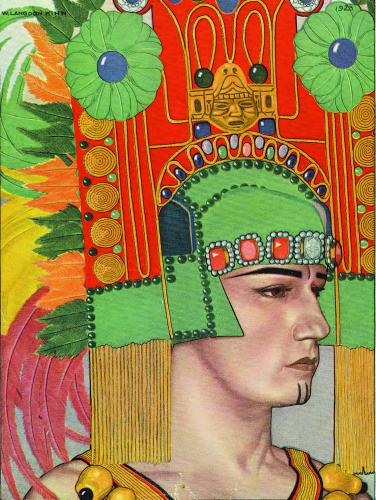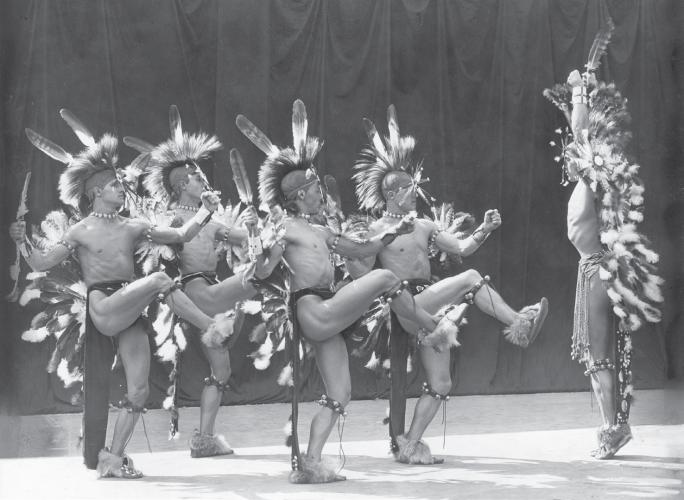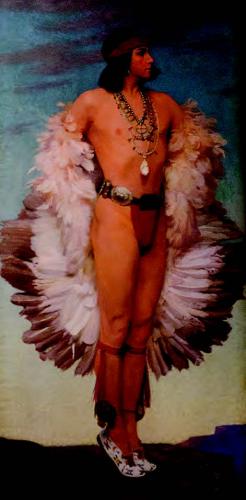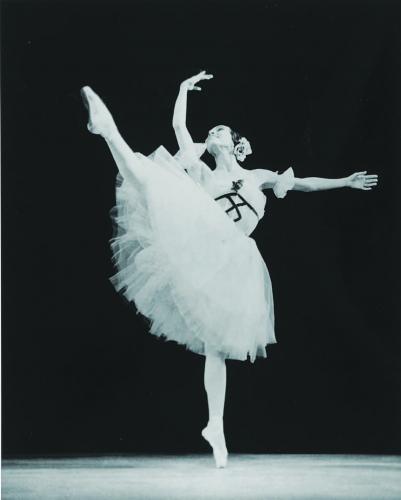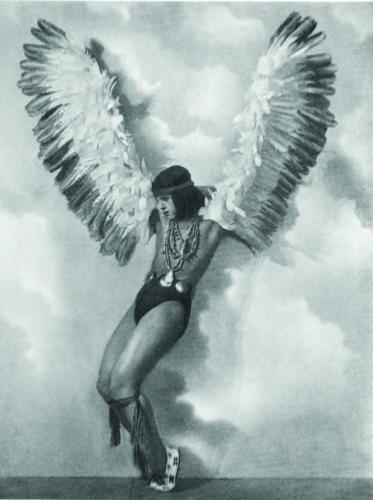Ted Shawn, a founder of American modern dance, was visiting Albuquerque, N.M., in January 1924 when a local friend told him she had just learned privately that the Isleta Pueblo was about to hold its annual Winter Solstice dance.
With his friend, Miss Erna Fergusson, Shawn drove for hours to the Pueblo, “white adobe houses around an open square, blue New Mexico sky, bluer than the Mediterranean at its best, and the inevitably right masses of color made by the Indians’ red blankets, coal black, straight hair, silver and turquoise jewelry.” Shawn watched all day, as some 60 dancers repeated their 40-minute pattern with a 20-minute rest period. Their rhythm, he wrote in his 1926 manifesto The American Ballet, was “worked out in metrical accuracy, and yet was so subtle that after watching it over and over again, I still do not know what it was.
“It was the most fascinating thing I have ever seen.”
The experience left Shawn with a deep appreciation of the primacy of this Native art, and indignation at its official neglect. “On the contrary,” he wrote, “the bureaucratic mind being what it is, the dancing of the Indians is looked upon as degrading, morally and industrially, and veiled threats in the form of letters from the Indian Commissioner, one of which I have read, indicate an official intention to blot out such remnants as still exist.”
Shawn added another mission to his already ambitious program. “This, surely, is one great charge laid upon the American dancers – to study, record and translate the dance art of the Indian to present and future generations.”
Shawn (1891–1972) was already a leader in the modern dance movement when he visited Isleta. As a theology student at the University of Denver, he had taken up dance as therapy after a bout of diphtheria left him nearly crippled, and this fascination led to his expulsion by the school’s Methodist administrators. Gravitating to the new world of the art form, he married kindred spirit Ruth St. Denis in 1915. Their Denishawn dance school and company became the nursery for the rising American dance generation. It also produced two installments of what Shawn called his Indian Trilogy.
A long fascination with Toltec and Aztec civilization had inspired the first ballet, Xochitl. The second leg, Feather of the Dawn, reinforced the Pueblo experience. The set reproduced the village of Walpi on the First Mesa of Arizona, and the costuming incorporated “authentic Hopi pieces.” Shawn commissioned the score from Charles Wakefield Cadman, a leading “Indianist” composer who worked from Native musical themes (some of which Cadman had recorded as a field researcher for the Smithsonian). Shawn said the third leg of the trilogy, still in scenario form, would deal with “the Esquimaux of Vancouver Island.” The intention was significant in spite of the confused ethnology. Shawn wrote at the peak of the Canadian government campaign to suppress the Potlatch ceremonies of the Kwakwaka’wakw peoples. Tribal leaders had been jailed and large quantities of sacred material had been confiscated (some of which wound up in George Gustav Heye’s Museum of the American Indian). Perhaps significantly, Shawn never produced this ballet.
Shawn separated from St. Denis around 1930 (although they never divorced) and took his Indian projects with him. In reaction to the split, he retreated to an abandoned farm in a remote section of the Berkshires in Western Massachusetts; in a double Biblical reference, it was called Jacob’s Pillow as the peak of steeply ascending stretch of state road known as Jacob’s Ladder. Developing an all-male dance company from students of a physical education course he taught at Springfield College, he reworked his Native material into a group version of a Ponca Dance, an Osage/Pawnee Dance and his own showcase, the Hopi Eagle Dance.
Shawn himself admitted that his ballets were adaptations, not “literal reproductions.” Although after observing the original, he tried to convey “its inner import as well as its visible pattern,” he said he was not a museum field worker. The limits of his ethnography show up in photographs of his early costumes; in one he wears as a Toltec headdress what appears to be a maiden’s kopatsoki from the Hopi Butterfly Dance. The Native choreography of his Men Dancers seems to have been drawn from two books of the early 1930s now in the Jacob’s Pillow archives, American Indian Dance Steps by the sisters Bessie Evans and May G. Evans and The Rhythm of the Redman by Julia M. Buttree. (The latter book, Shawn’s personal copy, is inscribed by the author both in her maiden name and as Mrs. Ernest Thompson Seton; Buttree was secretary to and then second wife of Seton, the famed nature writer, enthusiast for American Indians and co-founder of the Boy Scouts of America.)
The role of Shawn in preserving Indian dance was far less important, in fact, than the influence of the Native ceremonial spirit on Shawn’s own agenda. One of Shawn’s main goals in establishing Jacob’s Pillow and his Men Dancers was to overcome the Anglo-American prejudice against dancing as a legitimate male occupation. He turned to other cultures, such as the Indian, which gave men the primary role in ceremonial dance. “In all great nations of the past, as well as among savage and primitive peoples, the dancing has been done almost exclusively by men,” he wrote. He emphasized athleticism in his choreography and celebrated its origin as a physical expression of the hunter and the warrior.
Even more, however, was the intimate connection of Indian dance with religious ceremony. Shawn has been criticized unfairly for ignoring the spiritual side of Indian dance. (See the important but occasionally wrongheaded study of Indians and modern dance The People Have Never Stopped Dancing by Jacqueline Shea Murphy (University of Minnesota Press 2007). But as a former theology student he clearly understood that dance ultimately was deeply serious, an attempt to harmonize man with the divine. “Until big themes, religious themes, cosmic themes, become again considered as the natural and rightful field of the dance, many capable of doing big things will not see in the dance an opportunity for great art expression.” Although the Euro-American had largely lost this connection, Shawn and his sources found it still alive among the American Indian. As the Evans sisters wrote in their introduction, “in the dance the Indian finds a channel not only for the outlet of his esthetic nature but for the inflow of spiritual power.”
For all these reasons, Shawn and his peers saw the American Indian as the single-best model for the future of a vigorous, serious national dance. And although some critics say that Shawn’s own work seems out of date or limited by a show-business perspective, they all admit that his project is a resounding success.

